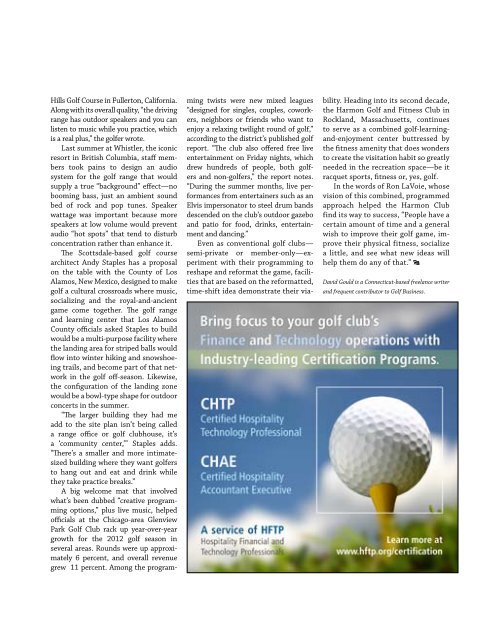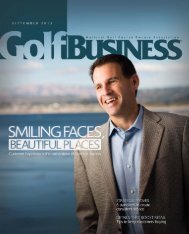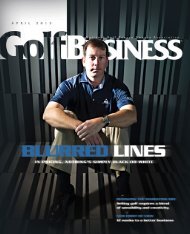Community - GolfBusiness
Community - GolfBusiness
Community - GolfBusiness
You also want an ePaper? Increase the reach of your titles
YUMPU automatically turns print PDFs into web optimized ePapers that Google loves.
Hills Golf Course in Fullerton, California.<br />
Along with its overall quality, “the driving<br />
range has outdoor speakers and you can<br />
listen to music while you practice, which<br />
is a real plus,” the golfer wrote.<br />
Last summer at Whistler, the iconic<br />
resort in British Columbia, staff members<br />
took pains to design an audio<br />
system for the golf range that would<br />
supply a true “background” effect—no<br />
booming bass, just an ambient sound<br />
bed of rock and pop tunes. Speaker<br />
wattage was important because more<br />
speakers at low volume would prevent<br />
audio “hot spots” that tend to disturb<br />
concentration rather than enhance it.<br />
The Scottsdale-based golf course<br />
architect Andy Staples has a proposal<br />
on the table with the County of Los<br />
Alamos, New Mexico, designed to make<br />
golf a cultural crossroads where music,<br />
socializing and the royal-and-ancient<br />
game come together. The golf range<br />
and learning center that Los Alamos<br />
County officials asked Staples to build<br />
would be a multi-purpose facility where<br />
the landing area for striped balls would<br />
flow into winter hiking and snowshoeing<br />
trails, and become part of that network<br />
in the golf off-season. Likewise,<br />
the configuration of the landing zone<br />
would be a bowl-type shape for outdoor<br />
concerts in the summer.<br />
“The larger building they had me<br />
add to the site plan isn’t being called<br />
a range office or golf clubhouse, it’s<br />
a ‘community center,’” Staples adds.<br />
“There’s a smaller and more intimatesized<br />
building where they want golfers<br />
to hang out and eat and drink while<br />
they take practice breaks.”<br />
A big welcome mat that involved<br />
what’s been dubbed “creative programming<br />
options,” plus live music, helped<br />
officials at the Chicago-area Glenview<br />
Park Golf Club rack up year-over-year<br />
growth for the 2012 golf season in<br />
several areas. Rounds were up approximately<br />
6 percent, and overall revenue<br />
grew 11 percent. Among the programming<br />
twists were new mixed leagues<br />
“designed for singles, couples, coworkers,<br />
neighbors or friends who want to<br />
enjoy a relaxing twilight round of golf,”<br />
according to the district’s published golf<br />
report. “The club also offered free live<br />
entertainment on Friday nights, which<br />
drew hundreds of people, both golfers<br />
and non-golfers,” the report notes.<br />
“During the summer months, live performances<br />
from entertainers such as an<br />
Elvis impersonator to steel drum bands<br />
descended on the club’s outdoor gazebo<br />
and patio for food, drinks, entertainment<br />
and dancing.”<br />
Even as conventional golf clubs—<br />
semi-private or member-only—experiment<br />
with their programming to<br />
reshape and reformat the game, facilities<br />
that are based on the reformatted,<br />
time-shift idea demonstrate their viability.<br />
Heading into its second decade,<br />
the Harmon Golf and Fitness Club in<br />
Rockland, Massachusetts, continues<br />
to serve as a combined golf-learningand-enjoyment<br />
center buttressed by<br />
the fitness amenity that does wonders<br />
to create the visitation habit so greatly<br />
needed in the recreation space—be it<br />
racquet sports, fitness or, yes, golf.<br />
In the words of Ron LaVoie, whose<br />
vision of this combined, programmed<br />
approach helped the Harmon Club<br />
find its way to success, “People have a<br />
certain amount of time and a general<br />
wish to improve their golf game, improve<br />
their physical fitness, socialize<br />
a little, and see what new ideas will<br />
help them do any of that.”<br />
David Gould is a Connecticut-based freelance writer<br />
and frequent contributor to Golf Business.




